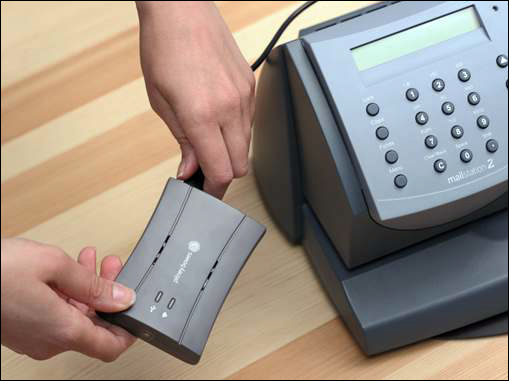The very nature of communication has changed dramatically since 1920, the year in which Pitney Bowes, a $3.6 billion provider of mailing and shipping services, started selling postage and metering equipment to businesses. Last year, the company began using General Electric’s Predix software to evaluate how it could make data from the mail-handling and -sorting machinery it sells to large enterprise customers more accessible to maintenance and technician teams (it now offers this as a software-as-a-service platform called Clarity). Now, working with IoT platform provider Electric Imp, Pitney Bowes is rolling out an IoT product for its small and medium-sized business (SMB) customers.
The product, called SmartLink, is a device that connects the metering machines that Pitney Bowes leases to SMBs to the Pitney Bowes Commerce Cloud, through which the machines are automatically updated whenever postage rates change. The cloud service also monitors each connected metering machine for ink and prepaid postage levels, alerting customers when they are running low—and customers who order ink refills through SmartLink receive a 20 percent discount. The SmartLink device also transmits the machine’s diagnostic data to the cloud, enabling both its customers and metering machine technicians to access and respond to error notifications.
“We are rolling out SmartLink in a variety of ways,” says Mark Shearer, the president of Pitney Bowes’ global SMB solutions business. SmartLink is compatible with Pitney Bowes’ low- and mid-volume mailing systems, including the K700 (Mailstation2), DM100i and DM200L models, and will be included in any new leases on those machines, without an additional charge. The device will also be sent, gratis, to customers who renew leases on those machines. Customers who are mid-stream on their leases can purchase SmartLink for $99.
Pitney Bowes will also embed the SmartLink into the new metering machines it is currently developing for the SMB market. (The U.S. Postal Service requires that meter manufacturers retain ownership of metering machines used within the United States, so all U.S. customers lease them.) Pitney Bowes has a total of 1.5 million clients globally, approximately 400,000 of which are SMB customers in the United States.
Shearer says Pitney Bowes developed SmartLink in response to research that showed customers want digital tools that make using the meters easier and more convenient. The company first engaged Electric Imp, which had initially been focused on the consumer market, in 2014, according to Oliver Hutaff, Electric Imp’s chief operational and financial officer. He says the high level of data security that the metering machines already use, and the ability to access a machine’s diagnostics data via its USB port—which works in a manner similar to a car’s OBD port—aided in the development process.
Postal meters are highly secure, Hutaff says, “because they’re essentially printing currency,” so while Electric Imp carried out security and penetration testing with Pitney Bowes to ensure that the internet link between the SmartLink device and the Commerce Cloud was secure, Pitney Bowes did not need to increase the data security of the meters themselves.
The SmartLink device is powered through mains power and is plugged into a meter’s USB port and then connected either directly to the office’s internet service, via an Ethernet cable, or wirelessly, by configuring the device’s Wi-Fi modem to join the network. (The SmartLink installation process does not require the meter to be reprogrammed or its firmware to be updated, Shearer notes, which were important design considerations aimed at making the device very easy to use.)
Once the device is connected, a user logs on to the Pitney Bowes website, pb.com (many customers already use the website to receive invoices, as well as order ink or other supplies from Pitney Bowes) and accesses the Commerce Cloud, the private cloud server where the SmartLink device transmits diagnostics, postage usage and ink levels from the meter.
Benefits Beyond Cheap Ink
Shearer says that connecting meters to the Commerce Cloud offers customers benefits beyond receiving notices of low ink or reminders to purchase more postage (which it does by analyzing past usage patterns to predict when a user is likely to consume a large amount of postage, such as while sending out monthly or quarterly statements). Currently, postage meters are linked to the Pitney Bowes network via a phone line, which is used to connect with the meter every 90 days, at which time any applicable postage rate increases are made to the machine. But should postage increase during that 90-day gap between connections, and if a user is unaware of the increase and sends mail at the old rate, the USPS can penalize that user and delay the delivery of the mail being sent. With SmartLink, any rate updates are made to the machine automatically.
“Plus,” Shearer says, “some customers that do not use traditional telephone service pay $30 or $50 a month just to have an old-fashioned analog line, so [for them] using SmartLink will remove that cost.”
As for the benefits that SmartLink provides to Pitney Bowes, Shearer says, customers’ ability to access the meters’ diagnostics data through Commerce Cloud could reduce demands on its customer service and technician teams, since those customers will be more easily able to fix some mechanical issues on their own, without having to call Pitney Bowes for help.
“What is so exciting about the SmartLink device is that we’re able to retrofit hundreds of thousands of meters,” Shearer states, noting that he first understood the promise of retrofitting existing systems when he installed Nest thermostats in his home. He sees some parallels between Nest and SmartLink, since they both add analog systems to the internet. “With Nest, I’m saving 40 percent of my oil consumption but using the same furnace [I already had].”



